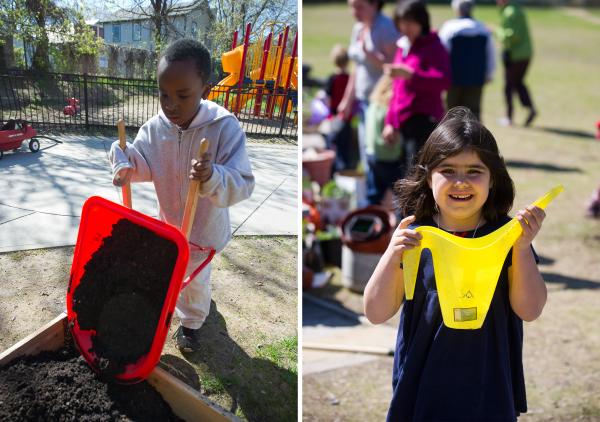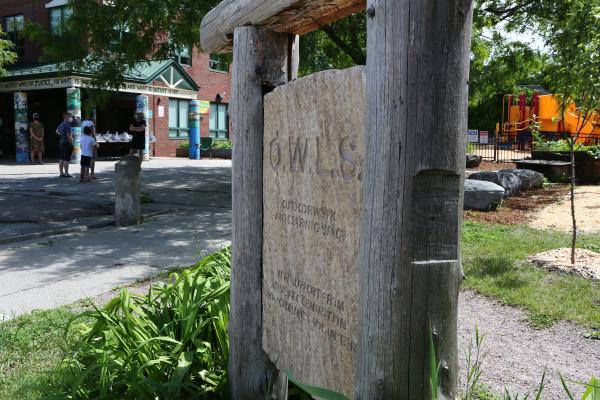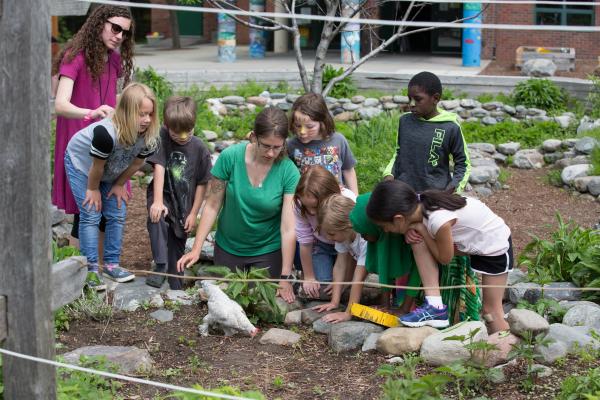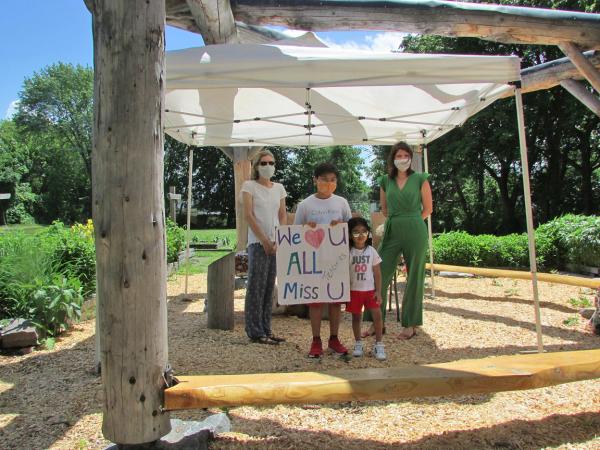What you are doing is so important to the community and our future. Thank you and excellent work!
Building Outdoor Learning Spaces: One School’s Experience
This guest blog is written by Kestrel Plump, former Shelburne Farms staff member and currently Sustainability Coach at the Sustainability Academy in Burlington, Vermont. In 2009-2010, Shelburne Farms helped launch the Sustainability Academy (more below).
Covid-19 has prompted a huge uptick in interest around outdoor education. But for many educators, such as myself, this type of education is nothing new.
As an outdoor educator, I’ve logged (pun intended) more hours teaching in the forest than in a classroom. But after seven years at Shelburne Farms, last fall I became a public school teacher -- the Sustainability Coach -- at the Sustainability Academy Elementary School (SA), a public magnet school in Burlington, Vermont that is focused on teaching students about economic, social, and environmental sustainability. The school and the Farm are close partners, and I’d already spent hours with students at the school’s outdoor learning spaces, so I felt relatively equipped for the job. Then, six months into my new position, the school closed due to COVID and we moved to remote learning for the remainder of the school year.
We are now back to in-person learning again, although everything feels, looks, and sounds very different. Many aspects of school have changed in ways we could not have predicted a year ago. And yet, we are all doing what we can to continue to be a consistent center of quality education and support of our students and families. Part of this means continuing and, where we can, expanding use of the school’s outdoor learning spaces.
Last week, I spent hours meeting with each teaching team to see when they wanted to be outside with their classes, making a spreadsheet of where and when all those classes would meet, and timing the entrances and exits from the building to avoid traffic jams of different pods of students.
I realized that while this scheduling was a bit of a chore, it was also a tribute to the success of these outdoor spaces, and to all the many people who have poured their time, brain power, energy, love and resources into imagining and creating them over the years. This completely shifted my outlook and I felt so grateful.
If you know anything about public schools or any type of large institution, then you know that things take time. Beautiful projects are possible, but will always encounter pitfalls and last minute changes. Some of the seedling ideas take shape and become amazing, useful things that are used every school day. In writing this blog, I got the chance to reach out to some incredible educators with whom I have worked over the past eight years to uncover more of the history of the place where I teach. Every person I reached named at least one other person who was essential to the project. For that reason, while I am certain that I have left out pieces and people in this the story, I am honored to share how Lawrence Barnes Elementary School transformed their outdoor space as a part of the transition to becoming Sustainability Academy, how that space is currently being used within the reality of Covid-19, and some of our past and present hopes for the future.
Before the school was the Sustainability Academy, it was Lawrence Barnes Elementary School. Some of the first significant contributions to creating outdoor learning spaces at the school were a mural and half a dozen garden beds that were built by Barnes families and teachers sometime before 2006.
In 2009-2010, the school and one of their partners, Shelburne Farms’ Sustainable Schools Project, moved to transform Lawrence Barnes into the Sustainability Academy). The school began working with University of Vermont students to transform the campus into a model of sustainability, with gardens and community gathering places. The students, part of a non-profit called ELI (Ecological Learning Institute) supported and collaborated in the design process. They held a series of charrettes where staff, students, families, and community partners identified outdoor learning, food, play, and community gathering features. The master plan, entitled the Schoolyard Transformation, was presented to the school in the Spring of 2010.
This year, COVID has raised new questions about how we use and adapt our outdoor spaces. For example, our gardens have been fabulously productive, but how can we harvest and distribute food in a safe and contactless way? And the space is still evolving: just this year we replaced several garden beds with recycled plastic TreX beds. Just this week, a city arborist delivered 36 stumps to use as chairs and tables in our outdoor kindergarten learning area. But other things are the same: outdoor learning continues to be enormously beneficial for students and requires a community and school wide effort to do it well.
If you are hoping to build an outdoor classroom or increase outdoor learning at your school, here are some takeaways from my experience and learning about the history at SA:
- Take on the project you can manage. You don't have to do everything at once.
- Road blocks will happen, but so will unexpected successes. Stay flexible and open to what is emerging while being clear about the overall goal.
- Find outside partners and resources: parental time and talent, other organizations, local businesses. I cannot stress this enough.
- Pay attention to non-human communities and what they are telling you about your space and how this can inform your plan. This is excellent work to do with students.
- Remember to look backwards as well as forwards. It is always so clear what we have left that we hope to do, but reflecting on what has been done as well is a more balanced assessment and can fuel hope.






